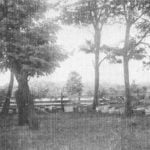
The Oak Hill apiary consists of twenty or more colonies, and their annual yield of comb honey ranges from 300 to 500 pounds. It was started with two colonies in the summer of 1905. These were obtained by the superintendent and H. C. Shoals, from two hollow trees in the timber near Red river, and were what are known as “wild bees.” They and their comb were placed in movable comb Langstroth hives, and the native queens were soon afterwards replaced by two pretty yellow Italian queens, obtained by mail from Little Rock. By this means the two colonies of wild bees, in the fall of the year, had become golden Italians.
A Double Swarm

On a pretty warm day in March, 1910, when the locust trees in the campus were in full bloom, two swarms of bees left their hives about the same time, and both clustered on the low, branching limbs of a small plum tree. After taking a photo of this unusual sight, Miss Weimer and Clarence Peete, who is standing behind the tree, each using a tin cup, gently lifted the bees from the limbs of the tree and placed them in a hive so arranged, that instead of destroying one of the queens, the bees naturally separated into two clusters around their respective queens. On the following morning, the swarm intended for Clarence was lifted out by him and put in a separate hive. The operations of hiving and separating the swarms were very successfully performed, without either of them receiving a single sting, and in the fall both colonies had a good supply of surplus honey. As an inducement to the young people to learn to manage bees profitably, a colony was presented to those who undertook the responsibility of caring for them at the Academy.
The first frost in the fall of the year indicates the time to remove the surplus honey from the hives; and to cut a bee-tree merely for its supply of honey and wax. April and May however, are the months to transfer colonies from boxes and hollow trees to movable comb hives, so as to save the “bee.”
A Model Hog House
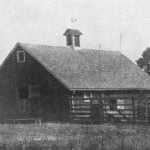
The following description of the hog house is given for the benefit of students and patrons. It was intended to be a model in the arrangement of every part and it is yet unsurpassed in the number of its conveniences. It was built in 1906 and is 24 by 32 feet.
An entry, four feet wide, extends through the length of the building and the pens, with outlots, are arranged on each side. The drip boards of the troughs are arranged along each side of this entry making them easy to fill without wetting the stock or pen. The floors intended for litter are further protected from dampness, by being elevated one inch from the rear to a line parallel with the trough, and about two feet from it. The litter is held on this elevated part of the floor by a guard, 2×4 inches, around its edge. Hanging partitions separate the entry from the pens. Fat hogs are easily and quickly loaded, by merely lifting the partitions and driving them through the entry into the open end of a wagon box, placed at the rear end of the entry.
It has a floor over head for receiving the corn from the field; husking and sorting it. On this loft there is a bin for storing the good corn intended for meal, and mouse-proof boxes for preserving seed corn on the ear until planting time. There are two hatches, one on each side at the rear for passing the husks for litter to the pens below. At the right near the front, there is a shute that conveys the corn for the pigs to a crib at the right in the first apartment below, from which it is taken at feeding time, by raising a self-closing lid near the floor. In the corner of this open apartment there is a large box covered with a hinged lid for ground feed, and a set of steps to the loft. Under the stairs, there is an elevator and purifying pump, that brings up pure and cool water from a brick walled cistern, underneath the floor of the building, and it has never gone dry, when used only for the hogs.
Old Log House
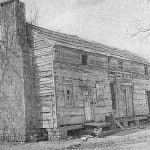
The old log house, which remained until 1910 and in which the school was founded, was for a half century the largest and best building occupied by the Choctaws in the south eastern part of their large reservation. During the period previous to 1860, when it was occupied by Bazeel Leflore, chief of the Choctaw Nation, its halls and spacious porches were the favorite places of meetings for the administration of tribal affairs, social and religious gatherings.
An Indian graveyard was located a few rods from its southeast corner. A neat little marble monument still marks the grave of Narcissa Leflore, wife of the chief Bazeel. She died at forty in 1854. Small marble tombstones, bearing the names of Leflore and Wilson, mark a half dozen other graves. One long, unnamed grave is marked by a broad wall of common rock, three feet high, covered with one large flag stone.
Chief Leflore, about the year 1860, located at Goodland, where he spent the remainder of his days. He left the log house to be occupied by John Wilson his nephew. About twenty years later Wilson left it to his son-in-law, Frank Locke, its last Choctaw occupant. He soon afterwards left it to Robin Clark, the Choctaw Freedman, from whom it was obtained in 1884, for the use of the school.
Painting
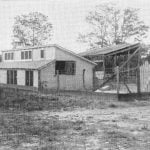
The pretty and attractive appearance of the premises at Oak Hill was due to a considerable extent to the good work of the boys that learned to use the brush in painting and white washing. The following facts are noted as an aid to them and others.
All the school buildings were painted cream and white. The materials used were white lead and flaxseed oil, mixed in the proportion of 15 to 20 pounds of lead to a gallon of oil. A gallon of the mixture is expected to cover 225 square feet of surface with two coats. The cream tint, a warm color, was obtained by mixing a little chrome yellow (and burnt sienna) with a pint or more of oil and adding as much of this mixture as was needed to produce the desired tint.
The red paint, used on the farm buildings and large gates, consisted of Venetian red, a dry paint, and oil, five to eight pounds of paint to the gallon of oil. A white trimmer was used on the face boards of the roof, doors and windows.
The white wash used on the board and pale fences consisted of quick lime slacked under water and gently stirred during this process. It should be allowed to stand a day or two before it is used. A pound of salt to the gallon of quicklime, the salt being first dissolved in water, improves its wearing quality. A little boiled rice flour improves its adhesiveness for indoor use.
Skimmed sweet milk, used the day it is mixed, is an inexpensive substitute for oil in applying Venetian red to old gates. One coat will make them look right well for one or more seasons. Milk however should never be used except to brighten up some old work for one or two years, and each gallon should contain three pounds of Portland cement, frequently stirred.
Seed Corn Improved
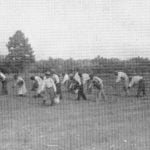
Large yields of corn are secured only by planting seed that has vitality sufficient to produce a good ear as well as a stock. Careful and successful farmers raise and endeavor to improve their seed from year to year. This may be done on a small scale as follows:
Select ten good sized, straight rowed, deep-grained ears. Remove the tips and butts. Shell each ear separately and plant in separate rows, marked and numbered from one to ten. As soon as the corn in these rows begins to tassel go through them every few days and remove the tassel from every stalk that is not forming an ear; so that the pollen or tassel dust of the barren stalk may not fall on the silks of the corn-bearing stalks.
At husking time husk and weigh the yield from each row or ear of seed separately. Missing hills and barren stocks indicate a low vitality in the seed-ear and also in the crop. Select the seed for the next year from the rows that yield the largest crop.
The yield of the cotton crop can be increased two fold by gathering the seed at picking time from only the best fruited stocks.
Health Hints.

Health means a sound mind in a sound body.
“Know thyself”, and remember, that “self-preservation is the first law of nature.”
An open window, day and night, is better than an open grave.
“Warm sleeping rooms have killed more people, than ever froze to death.”
“A good iron pump, over a well protected well, costs less than a case of typhoid.”
“Wire screens in the windows may keep crape from the door.”
“A fly in the milk often means a member of the family in the grave.”
Work when you work and rest outstretched, when you rest.
Avoid all sins of the flesh. Overeating and eating injurious foods or drinks are responsible for many ills of body and mind.
He who said, “I am the bread of life,” said also, “He that eateth me shall live by me.”
Cherish a cheerful, hopeful spirit by reading at least one promise from the Bible, for meditation, every day. Learn how to look pleasant, even when you may be feeling otherwise.
Fix the mind on the virtue to be cultivated rather than on the vice to be overcome.
If the heart action is sometimes weak, avoid all acts of over-exertion and sleep on the right side. Avoid snoring, by breathing through the nose.
Sleep is “nature’s sweet restorer.” Pure air, pure water and proper exercise are nature’s healthful invigorators. Use them freely.
Headache
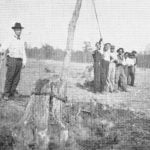
Headaches are due to three causes, namely, eye-strain, indigestion, and exposures to dampness and cold.
To avoid eye-strain, bathe the eyes frequently with cool water, and avoid using them intently too long, when the light is not good, especially in the twilight after sun set. To avoid the sick headache eat slowly and temperately; and drink water frequently both at and between meals. The ache in the back of the head, caused by exposure to drafts of air, cold and dampness to the feet, may be relieved by the application of hot damp cloths to the parts affected, and warming the feet and limbs until the perspiration is started. Never use dopes or preparations for headache, pure sparkling water is always much better.
Hot water
Hot water, sipped frequently, tends to relieve a cough, difficult breathing and a weak heart action. Pure air, inhaled by frequent daily deep breathings, and out-door exercise do more for weak lungs than medicines.
Chills
A chill is the protest of the liver or lungs after an exposure one or more days previous that was not followed by a proper warming of the feet, especially in the evening. Sulphate of quinine, a tonic for the stomach, is a standard remedy for malarial troubles but its use should always be preceded or accompanied with a tonic for the liver.
Smallpox
A mixture consisting of one ounce of cream of tartar, and two ounces of sulphur flour, should be in every home, to be taken a little occasionally as an antidote, and kept as an approved remedy for smallpox.

